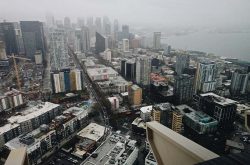
After a brutally hot, dry summer, chilly winds and soaking rain have finally returned to mark the start of autumn in the Pacific Northwest. According to Washington State Climatologist Nick Bond and Assistant State Climatologist Karin Bumbaco, both researchers in the Cooperative Institute for Climate, Ocean and Ecosystem Studies, chances are we’re due for a lot more cold, wet weather this winter. To understand why, we need to look somewhere unexpected: the tropical waters around the equator in the Pacific Ocean.
How El Niño and La Niña affect the weather
Each year, scientists monitor this region for the telltale signs of El Niño or La Niña conditions, which arise through a process known as El Niño-Southern Oscillation, or ENSO.
“During La Niña conditions, the waters off the western coast of South America tend to be much colder than normal, and the opposite is true during an El Niño year,” Bumbaco explains. “That affects air circulation along the equator and around the globe, so it has impacts on our weather worldwide.”
For the second year in a row, the National Weather Service’s Climate Prediction Center is anticipating a winter characterized by La Niña conditions. But what that means for the weather depends entirely on where you live. Here in the Pacific Northwest, La Niña typically brings cold air and higher than average rainfall from January through March, as well as a slightly elevated chance of snow in the lowlands of Western Washington. In Southern California and the southwestern U.S., however, it tends to result in below-average precipitation.

“What’s even more significant is the difference it makes on our snowpack by April 1,” Bumbaco says. “That’s typically when we have the most snowpack in our mountains, and in La Niña years, that tends to be higher. That’s really good news in terms of our water supply going into spring and summer.”
As this snowpack melts throughout the warmer months, it supplies essential water for agriculture and hydroelectric power generation, as well as the health of our forests, waterways and coastal ecosystems.
Back-to-back La Niñas may bring a gloomy autumn
The fact that it comes on the heels of another La Niña event just last winter could make this a particularly interesting year.
“When our office looked at back-to-back La Niña years throughout history, we saw that the second years tended to be a bit wetter from October to December,” Bumbaco recounts. “So, there may be some indication that it could impact us earlier in the winter than La Niña events traditionally do.”
Though it’ll require more research to confirm just how much influence this phenomenon has had already this year, the autumn’s dreary start could well be thanks to these recurring La Niña events.

How ENSO could change as the climate warms
La Niña and El Niño events don’t follow a predictable pattern, but, on average, they tend to occur every two to seven years. As the climate changes, though, some research indicates that those patterns could change significantly.
“To a certain extent, we don’t really know how climate change will affect ENSO,” Bond says. “Some of the climate models we use show a more vigorous cycle between La Niña and El Niño in the coming decades, while others show a much more muted cycle. The real concern, especially for the southwestern U.S., is that if the ENSO cycle becomes stronger, La Niña years will dry the region out even further and exacerbate droughts.”
Bond is quick to clarify that La Niña and El Niño don’t dictate exactly what the weather will be like in a given winter. “It’s not a switch,” he says. “It just tilts the roulette wheel.” The influence of other seasonal cycles, as well as the randomness inherent in global weather, make it hard to forecast this far out with much certainty. But based on what we know right now, it appears this winter is likely to be a cold, wet and snowy one in the Pacific Northwest.
Still have more questions about ENSO? Check out our video interview with Bond, and find out if he prefers El Niño or La Niña!

